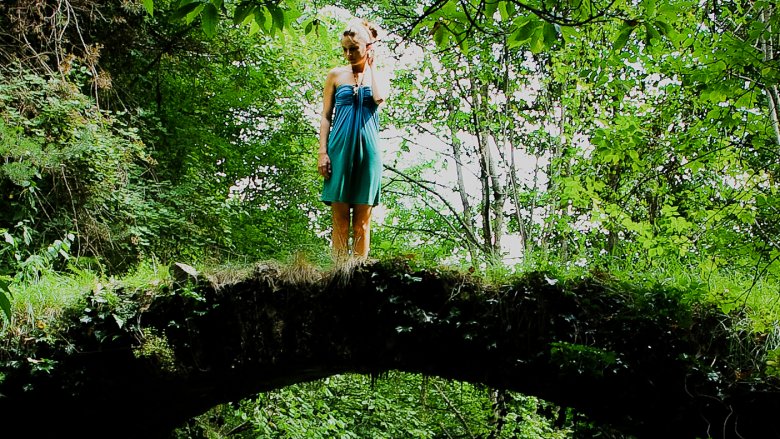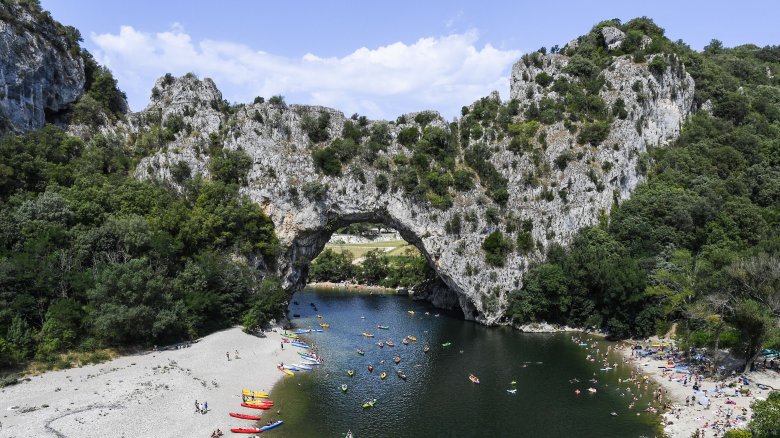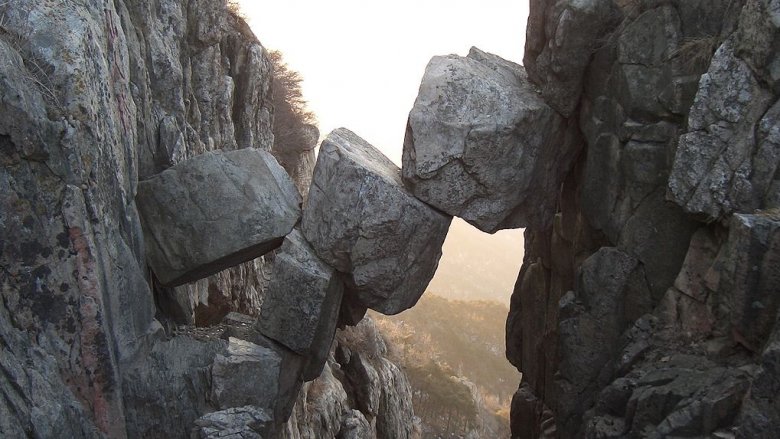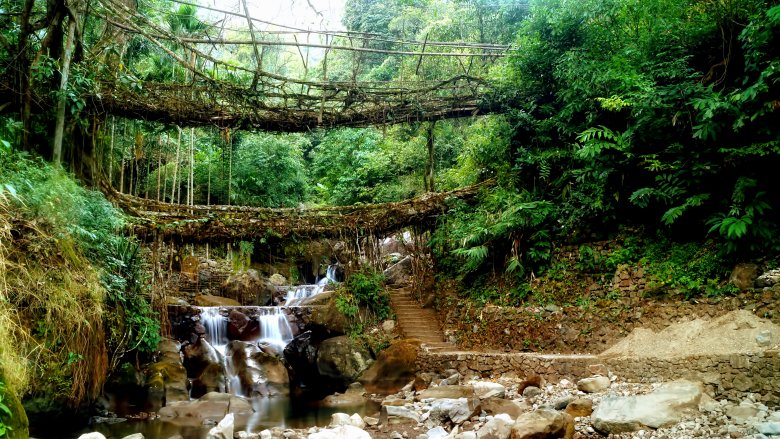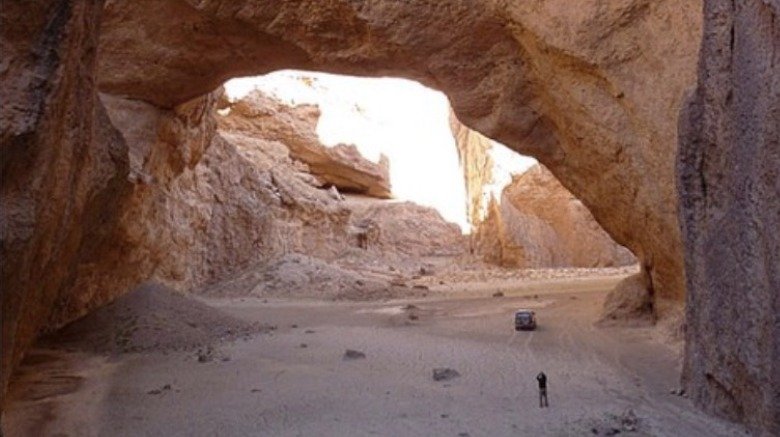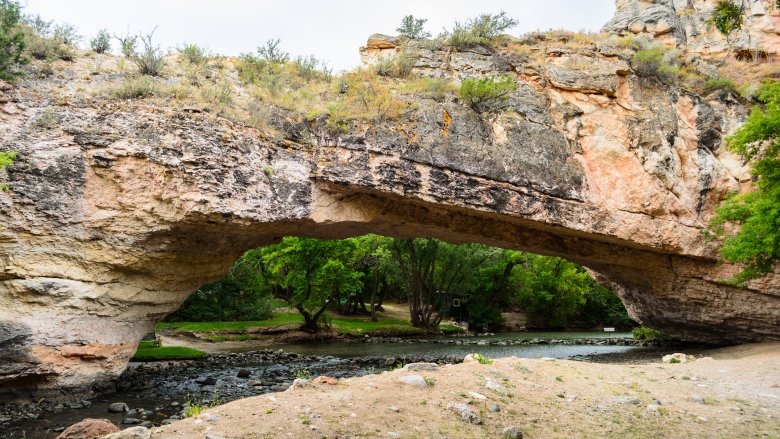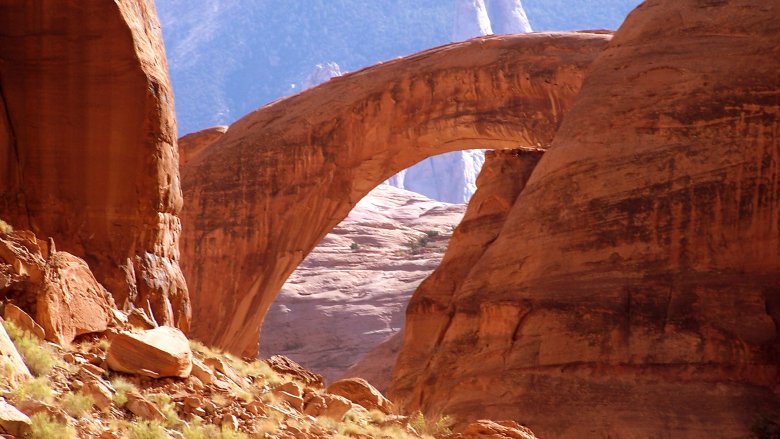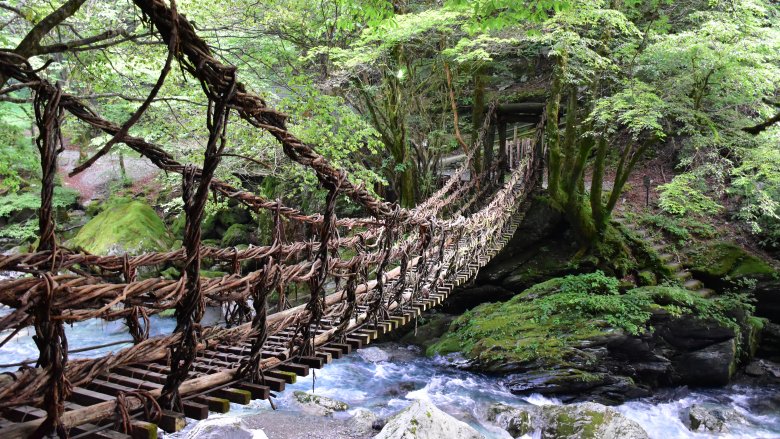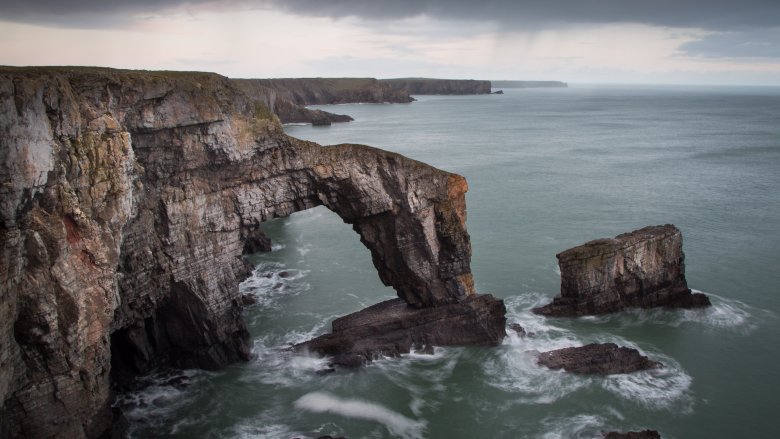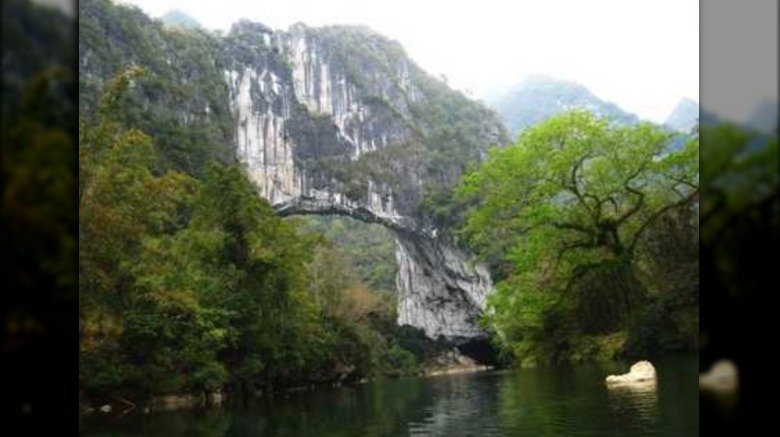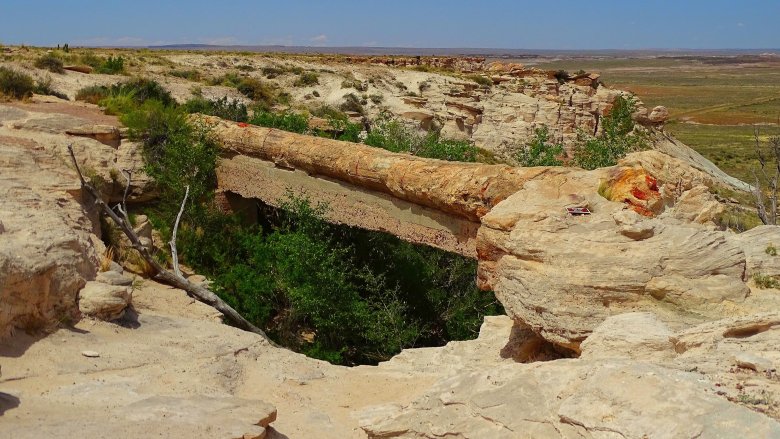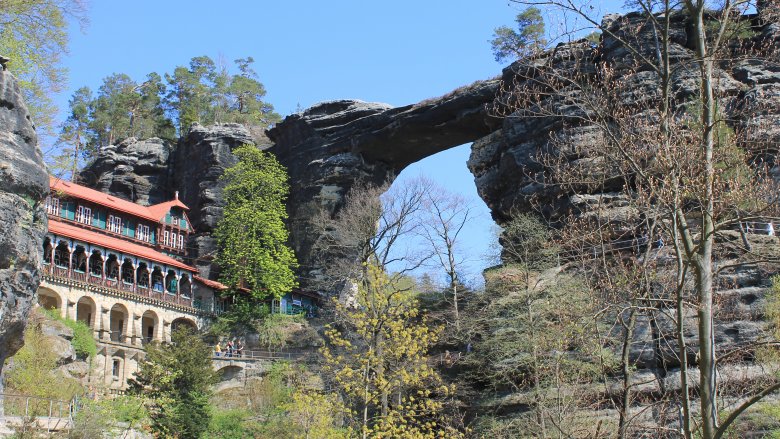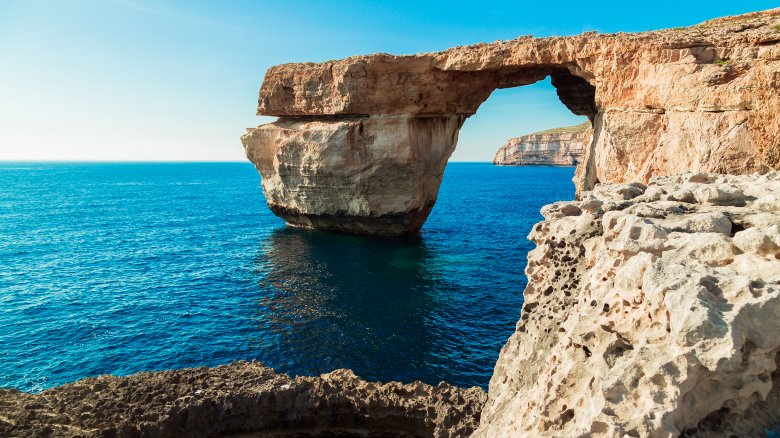13 Coolest Natural Bridges In The World
Man-made bridges are huge undertakings that can cost a fortune in dollars, time, and manpower. The most expensive bridge ever built is California's Oakland Bay Bridge, which cost an estimated $6.3 billion. Even a simple pedestrian bridge isn't a small undertaking. A pedestrian bridge has to be engineered to be sturdy enough for thousands of travelers to cross over a period of many years, so it might cost a city between $1 million and $5 million dollars to design and build a safe one.
And yet, nature has figured out how to make bridges, too, and it costs nature exactly zero dollars and zero manpower. What it saves in cost and labor, though, it makes up for in time. Most natural bridges are created by natural processes over thousands of years (note there's a difference between a natural arch and a natural bridge — natural bridges are created by water, while natural arches are created by other natural forces, like wind and gravity). Others — like root and vine bridges — are mostly natural, but are created with a little help from human beings. Here are some of nature's most impressive bridge-building accomplishments (with an occasional helping hand from nature's least-natural creature: Us).
Beyond this natural bridge, you'll find the world's oldest cave paintings
Pont d'Arc crosses France's Ardeche River near Ardeche Canyon, where you could see the Chauvet-Pont d'Arc cave paintings, except for the part where you're not actually allowed to see them (you can visit a replica cave, though, and pretend like it was the real thing). Still, this beautiful and massive natural bridge is enough to make your visit to the area worthwhile. According to Atlas Obscura, the arch marks the entrance to the canyon, and you can canoe or kayak or even swim underneath it. There is also a beach on both sides of the bridge, so if you're looking for seclusion and quiet beauty you're probably not going to find it at Pont d'Arc — it's a tourist favorite, and the locals sometimes even hold rowing competitions there.
Pont d'Arc is about 220 feet high and roughly 200 feet long. Unlike a lot of the world's natural arches and bridges, Pont d'Arc is covered in green vegetation so if you could erase all the tourists it would be a pretty idyllic spot. Sadly, there's really no such thing as idyllic anymore.
You probably don't want to try crossing this bridge
Technically speaking, the Immortal Bridge of Mount Tai in China isn't really a natural bridge, because it wasn't formed by water. It also wasn't formed by wind, which is the force responsible for many of the world's natural arches. This particular bridge was created by gravity, and instead of eroding gradually over time it may have been created in an instant.
According to The Geologist, the bridge was formed when huge boulders plummeted towards the earth but got stuck in the narrow space between two sheer cliff faces. The formation looks like it could collapse at any moment, but there's surprisingly little danger of that — it's probably been there for millions of years, and it's not really showing any signs of instability.
That's not where the bridge got its name, though. The name comes from a legend that says anyone brave enough to cross the bridge will attain immortality. Don't try it, though. Because even if it was true (it's not) plummeting to your death is totally not worth immortality.
These bridges are alive
Sometimes you just can't wait around for wind or water to do its thing, and it's kind of a crap shoot as far as depending on an earthquake or some other act of gravity to create a bridge just where you happen to need one. But not everyone can spend $1 million to $5 million on a pedestrian bridge, either. So the people of Meghalaya, India, have developed an ingenious way to coax nature into building some pretty cool natural bridges for them.
According to National Geographic, the plateau between Assam and Bangladesh is one of the wettest places on Earth, with a fierce monsoon season that sends torrential rainwater through the gorges where the Khasi tribes live. The Khasi need to cross those gorges, so they create a temporary bamboo scaffolding next to Ficus trees that they've planted on either side of the gorges, and then they twist the trees' roots through the scaffolding to form a bridge.
You can't build a bridge this way in a weekend, though, or even in six months — it takes 15 to 30 years for the bridge to grow sturdy enough for people to use. But the advantage is that the living root bridges of Meghalaya can last for centuries, and they don't get washed away by high, fast, waters. Also, they're great for tourism — Meghalaya and its root bridges are one of the top attractions in the region.
This natural bridge was "discovered" only a few years ago
It's remarkable to think that something as amazing and massive as a natural stone bridge could remain undiscovered for so long — and let's face it, someone, somewhere, probably did "discover" the thing before 2010, it's just that it was a discovery that never got written down. Anyway, this particular bridge is in a remote part of Afghanistan, almost 10,000 feet above sea level. It was first sighted by researchers from the Wildlife Conservation Society, who were surveying the area for ibex and wild sheep.
The Hazarchishma Natural Bridge spans 210.6 feet, which makes it the 12th largest known natural bridge in the world, displacing Utah's 206-foot Outlaw Arch, the former 12th place holder. According to the Natural Arch and Bridge Society, Hazarchishma Natural Bridge is a young "meander natural bridge," which is an arch formed by a stream or streambed. There's no water running beneath it today, though — the waters that formed it are now subterranean.
Hazarchishma Natural bridge is made from ancient limestone that's probably as old as the dinosaurs. The site is also close to a series of caves where early humans might have lived, and there's an ancient fort nearby, too. Cool place, but, you know, Afghanistan. You might want to wait until things calm down a bit over there before scheduling your visit.
The maybe-haunted natural bridge of Wyoming where you can also camp and play volleyball
There are only three natural bridges in the United States that still cross water, and one of them is Ayres Natural Bridge, which is located in Wyoming just south of the Oregon Trail. Laperle Creek passes beneath the bridge, and the place has been transformed into a touristy little park, complete with camping, a picnic area, a sand volleyball court, and a horseshoe pit. So enjoy the serenity of nature.
According to the Natural Arch and Bridge Society, Ayres has a span of 50 feet and a height of 30 feet. It has a long history, too, and not all of it is sunny — the local native population has a legend about a young man who was killed by a lightning strike in the canyon, and now they say there's an evil spirit living under the bridge. White settlers heard this legend, too, but they quickly realized that the natives avoided the bridge, which made it a good place to hide when there was conflict between themselves and the locals.
The rainbow that turned to stone
Utah has a lot of natural arches and bridges, and it also has one of the world's largest. Located on indigenous land on the Colorado Plateau, the Navajo called it "nonnezoshi," which means "rainbow turned to stone." Called simply "Rainbow Bridge" by the National Park Service, it does look an awful lot like its name.
According to the Chicago Tribune, Rainbow Bridge was formed over millennia, first by winds that piled sands a thousand feed deep across Arizona and Utah, and then by inland seas that washed over the sand and then left it to dry and become stone. Volcanic activity caused the sandstone to bend and twist, and rivers that flowed through the region carved it into impressive shapes — at 290 feet high and 275 feet long, Rainbow Bridge is one of the most impressive. In the Navajo legend, the bridge was formed by the Sky Father, who cast a rainbow over floodwaters to allow a young god to escape.
Before humans built nearby Lake Powell, Rainbow Bridge could only be visited by determined travelers who were willing to go on a difficult, 15-mile, overnight trek through the desert. Today you can get there by boat.
Vines are a scary way to get around
Everyone knows if you're in the jungle and you want to get from tree A to tree B, you grab a vine, pound your chest a couple of times, make a weird, guttural, jungle-yodel sound, and swing. Except you wouldn't really do that, of course, because the vine might actually break and you'd look ridiculous.
There is at least one place in the world where vines actually are used to go places, but the locals don't swing on them. West Iya Valley in Japan is a land of rivers and gorges, and because it's so remote it was once an obvious place for unsavory types to hide out. The bandits and refugees who made the valley their home needed to build bridges over the river, but being bandits and refugees, it's not like they had a ton of capital to devote to bridge-building projects. So they made bridges out ridiculously long vines they stretched across the river and wound together. According to Atlas Obscura, vine bridges were handy for the refugees because although they had plank flooring, they had no handrails, which made them especially dangerous for the uninitiated to cross. They could also be easily cut down, thus thwarting pursuers.
Today the vine bridges built by the locals are reinforced and have handrails, but they're still a terrifying experience. The biggest vine bridge in Iya is 150 feet long and 50 feet high. You can even cross one for 500 yen.
This arch is eroding away in front of our eyes
Oceans can make natural bridges, too, and one of the most amazing can be found off the coast of Pembrokeshire, Wales. Named for the green vegetation that grows on top of it, the Green Bridge spans the Walsh bay and is 80 feet high and 66 feet long. According to Britain Express, the bridge is made of carboniferous limestone, and it was carved by a combination of wind, rain, and ocean waves. Before it was an arch, it was a pair of caves — over time the waves made the caves deeper and deeper until they finally met in the middle and a natural bridge was born.
Climbing is a popular activity in the Green Bridge area, but the site is also important for nesting seabirds like razorbills, guillemots, and cormorants, so climbing is limited to the months after the birds have fledged and moved on.
Like all natural bridges, Green Bridge continues to be vulnerable to the processes of erosion, and in 2017 it sort of eroded away right in front of everyone's eyes after Hurricane Ophelia knocked part of the arch's outer block into the sea.
There aren't really any fairies living under this bridge ... probably
It's easy to imagine sprites and other mythical creatures flitting around beneath China's Fairy Bridge — photos do a pretty good job of communicating how magical the place is, but it's got to be a pretty amazing experience to actually raft under the 400-foot wide span crossing China's Buliu River. Fairy Bridge has the longest known span of any natural arch in the world, and if that's not already impressive enough, it's also draped in beautiful, lush, green vegetation.
Fairy Bridge is not very well-known, though, nor is it especially well-traveled. According to the Natural Arch and Bridge Society, Fairy Bridge (locally known as Xian Ren Qiao) is in a remote part of China, and it's only accessible via raft. From upstream, the bridge can be reached via rubber raft, and the three-hour journey from the village of Buliu includes several minor rapids and at least two major ones. From downstream, the locals take visitors to see the bridge on flat, bamboo rafts with wooden chairs attached to them. The good news is that tourists haven't inundated the area (yet) so there's a good chance you won't have any picnickers or volleyball games disrupting the peace and serenity of the area. Or scaring away the fairies.
A natural bridge made out of a petrified tree
If you enjoy hiking in wooded regions, you probably use natural bridges all the time. Fallen logs make handy, if precarious river crossings, and some parks will actually convert them into proper bridges complete with handrails. But there are some log bridges that you just need to stay the heck off, not only because they're perilous but also because foot traffic could actually destroy them forever.
One of the most famous log bridges is located in Petrified Forest National Park in northeastern Arizona. Called Agate Bridge, it's made from a 110-foot petrified tree crossing a 40-foot wide gully. According to Parkcation, the tree has been in its present location for at least 200 million years, and the gully likely formed after it was petrified, as water exposed it and continued to erode the material underneath it.
Agate Bridge has been a national monument since 1906, and it was only a few years later that people realized it needed to be reinforced and protected. In 1917 a concrete span was built beneath it to help support it, and masonry pillars were added in 1922. Still, the bridge is precarious enough that it's expected to collapse at some point, and the National Park Service has no plans to stop that from happening. Their philosophy is to just let natural forces take their course. Sorry, though, you can't help hasten the process along by walking on the bridge — that's strictly prohibited.
See any lions, witches, or ... err ... wardrobes?
The stunningly beautiful mountain setting where this arch is located attracts tourists and moviemakers, too — Pavcicka Brana appeared in the 2005 movie The Chronicles of Narnia. In the film, characters can be seen crossing the snow-covered bridge, but alas, it's only movie magic that made that scene possible. According to As We Saw It, the bridge was closed to foot traffic after it became apparent that people were creating stress that might eventually lead to its collapse. In The Chronicles of Narnia, the characters were added digitally.
Pavcicka Brana was formed beneath an inland Jurassic sea, which left behind massive sandstone deposits that were eroded over time by wind and rain. Technically, that makes it an arch rather than a bridge, but as the largest such structure in Europe, we think it still deserves a place on this list.
Pavcicka Brana is located in the Czech Republic, and at 87 feet long and 52 feet high, it's an impressive sight, though you can only get there on foot. Adjacent to the arch is a cool old building called Falcon's Nest, which was built in 1881 and used to be a hotel — today it serves a restaurant and a photo gallery.
Even this famous sea arch couldn't stand the ending of Game of Thrones
Any sailor can tell you, the ocean can be merciless. It swallows up ships, it sends hurricanes hurling towards land, and it occasionally takes out our favorite landmarks, too. In 2017, the Mediterranean reminded us all just how badass it can be when it destroyed one of Malta's most important tourist attractions, a sea arch called the Azure Window.
If you're a Game of Thrones fan (or if you were a Game of Thrones fan before Game of Thrones was ruined by its epically sucky ending) you might recognize photos of the former-arch — it's where Daenerys Targaryen married Khal Drogo in the first season. According to The Irish Times, geologists have been saying for a while that the Azure Window's days were likely numbered, but no one ever listens to geologists. The geologists were right, though. A storm struck the area on March 8, 2017, and the rough seas were enough to send the arch tumbling down. Maybe the arch was just protesting its involvement in history's most disappointing television series.
Anyway, all is not lost — the fallen arch continues to be a tourist attraction for divers. The sunken arch has created an underwater maze of canyons and passages for enthusiasts to explore. So that's cool, if you're a diver. For everyone else, the Azure Window will be forever missed.
Crazy cool bridges made from ... insects
You won't be able to walk on one of these bridges. Well, you could, but you'd destroy the bridge and also it would be a seriously sociopathic thing to do.
Ant bridges are among the smallest of all natural bridges — they are made by living ants, which will naturally form a span over a gap they encounter just by using their own bodies. According to Quanta Magazine, the ants use a basic algorithm to determine where and how they should build a bridge. First, an ant that encounters a gap will slow down, prompting the rest of the ants to walk over it. But instead of saying "Hey, guys, stop walking on me," the ant is programmed to freeze in place, because remember that ants are actually small and stupid and they have no autonomy. So when the ants step over their frozen comrade, they will also encounter the gap, it's just that little bit smaller because there is a frozen ant hanging over the first part of it. So then those ants will slow down, the ants behind them will walk over them, more ants will freeze in place ... and so on until you've got one of the coolest, extra-small natural bridges in the world.
